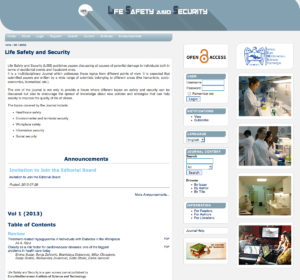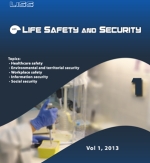By Bartolomeo Sammartino and Francesco Cappello
Euro-Mediterranean Institute of Science and Technology, Palermo, Italy
visit the Website
LiSS is a multidisciplinary Journal that addresses the topics cited above from different points of view. It is expected that the papers submitted to the Journal will be written by a wide range of scientists active in different fields (such as humanistic, socio-economic, biomedical, etc.). The aim of the Journal is to not only provide a forum where different topics on safety and security can be discussed, but also to encourage the spread of knowledge on new policies and strategies that can help society improve the quality of life of citizens.
The main topics covered by the Journal include: Healthcare safety; Environmental safety; Workplace safety; Information security; Social security.
These topics are central to the next calls of the European Horizon 2020 Program, that include, among others, the following themes:
• Health, demographic change and wellbeing, including: Understanding the determinants of health, improving health promotion and disease prevention; Developing effective screening programs and improving the assessment of disease susceptibility; Improving surveillance and preparedness; Understanding disease; Developing better preventive vaccines; Improving diagnosis; Using in-silico medicine for improving disease management and prediction; Treating disease; Transferring knowledge to clinical practice and scalable innovation actions; Better use of health data; Improving scientific tools and methods to support policy making and regulatory needs; Active ageing, independent and assisted living; Individual empowerment for self-management of health; Promoting integrated care; Optimizing the efficiency and effectiveness off healthcare systems and reducing inequalities through evidence based decision making and dissemination of best practice, and innovative technologies and approaches. 
• Food Security, sustainable agriculture, marine and maritime research and the bio-economy, including: Sustainable agriculture and forestry; Sustainable and competitive agri-food sector for a safe and healthy diet; Unlocking the potential of aquatic living resources; Sustainable and competitive bio-based industries.
• Secure, clean and efficient energy, including: Reducing energy consumption and carbon footprint through smart and sustainable usage; Low-cost, low-carbon electricity supply; Alternative fuels and mobile energy sources; A single, smart European electricity grid; New knowledge and technologies; Robust decision making and public engagement; Market uptake of energy innovation, empowering markets and consumers.
• Smart, green and integrated transport, including: Resource efficient transport that respects the environment; Better mobility, less congestion, more safety and security; Global leadership for the European transport industry.
• Climate action, resource efficiency and raw materials, including: Fighting and adapting to climate change; Sustainably managing natural resources and ecosystems; Ensuring the sustainable supply of non-energy and non-agricultural raw materials; Enabling the transition towards a green economy through eco-innovation; Developing comprehensive and sustained global environmental observation and information systems.
• Inclusive, innovative and reflective societies, including: Promoting smart, sustainable and inclusive growth; Building resilient and inclusive societies in Europe; Strengthening Europe’s role as a global actor; Closing the research and innovation divide in Europe; Strengthening the evidence base and support for the Innovation Union and European Research Area; Exploring new forms of innovation, including social innovation and creativity; Ensuring societal engagement in research and innovation; Promoting coherent and effective cooperation with third countries; Study European heritage, memory, identity, integration and cultural interaction and translation, including its representations in cultural and scientific collections, archives and museums, to better inform and understand the present by richer interpretations of the past; Research into European countries’ and regions’ history, literature, art, philosophy and religions and how these have informed contemporary European diversity; Research on Europe’s role in the world, on the mutual influence and ties between the world regions, and a view from outside European cultures.
• Secure societies to protect freedom and security of Europe and its citizens, including: Fighting crime and terrorism; Strengthening security through border management; Providing cyber security; Increasing Europe’s resilience to crises and disasters; Ensuring privacy and freedom in the internet and enhancing the societal dimension of security.
The sections of the Journals include:
· Articles: These works are original reports whose conclusions represent a substantial advance in the understanding of safety and security cases, and have immediate, far-reaching implications. Articles must include a summary, separate from the main text, of up to 150 words, with no references, and it should not contain numbers, abbreviations, acronyms or measurements unless essential.
It should also be easily understood by readers with no previous knowledge on the discipline. This summary must contain a paragraph (two to three sentences) with a basic-level introduction to the field; a brief account of the background and rationale of the work; a statement of the main conclusions (introduced by the phrase ‚In the present work we show‘ or equivalent); and, finally, two to three sentences putting the main findings into a general context so it is clear how the results described in the paper helped to advance the field of study. The text may contain a few short subheadings. Articles typically have five or six display items (figures or tables). Monographs and Case Reports are also welcome. Monographs are contributions on a single subject or aspect, on topics concerning human sciences. Case Reports are detailed medical reports of the symptoms and signs of unusual or novel occurrences, and the diagnosis, treatment, and follow-up of patients.
· Communications: These manuscripts should be restricted to reports of unusual urgency, timeliness, significance, and broad interest. A brief statement explaining how the submission meets the criteria of urgency and significance should be included in the author’s cover letter. It is desirable for the principal conclusions to be stated in the opening sentences of the manuscript. Communications of up to four Journal pages will be considered. The submission of multiple Communications on the same or closely related topics within a short period of time is not an acceptable means of attempting to publish a body of work that is too large for a single Communication. Such work should be formatted and submitted as an Article. The major concepts must not have appeared previously in a report or publication (e.g., published lecture or news release, electronic journal paper or preprint, symposium proceedings, or extended abstract). If Communications on the subject by the same author(s) have already been published, and the present manuscript describes a technical improvement or increase in the scope of the work, it will not be accepted unless novel conceptual advances have been determined.
· Reviews: LiSS publishes three kinds of reviews, Comprehensive Reviews, Perspective Articles and Analyses. It also publishes commissioned collections of reviews and other related materials on a single scientific theme as ‚Insights‘ a few times per year. Reviews should focus on one topical aspect of a field rather than providing a comprehensive literature survey. They can be controversial, but in such cases, the manuscript should briefly describe the opposing viewpoints. They should not be focused on the author’s own work. Review-based reports including a new analysis of existing data leading to a novel, exciting and arresting conclusion. Language should be simple, novel concepts defined and specialist terminology explained. All Reviews must start with a preface of up to 100 words, which should set the stage and end with a summary sentence. Please note that the preface will also appear on PubMed and Medline, so it is important that it contains essential key words. Display items and explanatory boxes (used for explanation of technical points or background material) are welcomed. The author is responsible for ensuring that the necessary permission has been obtained for the re-use of any figures previously published elsewhere.
· Technology Features and Hypotheses: These works are published a few times per year to review techniques and technologies of fundamental importance in fast-moving fields of research. Technical Comments should not present new data or other previously unpublished work, or be based on new findings/concepts that would not have been accessible to the authors when the quoted paper was written. Pertinent comments on non-technical aspects of a paper should be submitted as online comments.
· Social Forum (1000 to 2000 words, one to two figures, and up to 15 references): The Social Forum presents issues related to the intersections between science, technology and society that have political and educational implications.
We are currently looking for new members of our Editorial Board. Presently, 18 distinguished researchers, including the Nobel Prize winner Kary Mullis, have joined our editorial board. If you think that, based on your contributions in the field of Safety and Security, we should invite you to join us as an Editorial Board Member of the journal, please do not hesitate to contact us by email, including your c.v., at liss@iemest.eu. As an Editorial Board Member, you will be required to occasionally review research papers, articles and letters, and solicit articles from your colleagues, as well as to help in promoting the journal at conferences and meetings that you attend.
For the first two Issues (2013 and 2014) all articles, including figures and tables, with no length limitations, will be published free of charge! We hope that researchers in this field will not miss the opportunity to submit their papers for publication in our Journal.
For more Information visit the Website.
Tip: More up to date educational events dealing with healthcare safety can be found online on the Education Database »medicine & health«.


